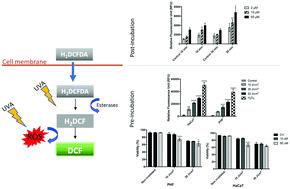当前位置:
X-MOL 学术
›
Photochem. Photobiol. Sci.
›
论文详情
Our official English website, www.x-mol.net, welcomes your feedback! (Note: you will need to create a separate account there.)
Implications of dichlorofluorescein photoinstability for detection of UVA-induced oxidative stress in fibroblasts and keratinocyte cells.
Photochemical & Photobiological Sciences ( IF 3.1 ) Pub Date : 2019-11-21 , DOI: 10.1039/c9pp00415g Carla Souza 1 , Danielli Azevedo Mônico 1 , Antonio Claudio Tedesco 1
Photochemical & Photobiological Sciences ( IF 3.1 ) Pub Date : 2019-11-21 , DOI: 10.1039/c9pp00415g Carla Souza 1 , Danielli Azevedo Mônico 1 , Antonio Claudio Tedesco 1
Affiliation

|
Although the dichlorofluorescein (DCF) assay is widely used to detect the production of UVA-induced ROS, the photostability and phototoxicity of the probe after UVA irradiation remains controversial and the experimental conditions often vary across studies, making it difficult to compare results from different studies. This study aimed to evaluate the suitability of the DCF assay for detection of UVA-induced ROS in human cells after UVA irradiation. Human primary fibroblasts (HPF) and HaCaT cells were loaded with 2′,7′-dichlorodihydrofluorescein diacetate (DCFDA) (2, 10, and 50 μM) for 10 and 30 min, before and after exposure to UVA radiation (5–50 J cm−2). Fluorescence was recorded immediately or 30 min after irradiation using three different techniques: microplate reading, flow cytometry, and confocal scanning microscopy. Cell viability was assessed by flow cytometry before and after UVA exposure. A UVA-dose-dependent increase in ROS was observed at 5–50 μM DCFDA, and the magnitude of the fluorescent signal was affected by RPMI medium, as well as DCFDA loading concentration and incubation period. However, higher concentrations of DCFDA compromised the viability of both HaCaT and HPF cells after UVA irradiation. The most sensitive and reliable combination for the ROS assay was pre-incubation with 10 μM DCFDA for 30 min in PBS. Reading the fluorescence 30 min after UVA irradiation diminished the emission signal, as did the DCFDA post-incubation. In conclusion, this single-point DCF assay allowed reproducible and sensitive UVA-induced ROS detection in HaCaT and HPF cells without compromising the cell viability or morphology.
中文翻译:

二氯荧光素光不稳定性对检测UVA诱导的成纤维细胞和角质形成细胞氧化应激的影响。
尽管二氯荧光素(DCF)测定法被广泛用于检测UVA诱导的ROS的产生,但在UVA照射后探针的光稳定性和光毒性仍然存在争议,并且实验条件在各个研究中经常有所不同,因此很难比较不同研究的结果。这项研究旨在评估DCF分析在UVA照射后检测人细胞中UVA诱导的ROS的适用性。在暴露于UVA辐射(5-50 J)之前和之后,在人类原代成纤维细胞(HPF)和HaCaT细胞中分别加载2',7'-二氯二氢荧光素二乙酸酯(DCFDA)(2、10和50μM)10和30分钟。厘米-2)。使用三种不同技术立即记录荧光或照射后30分钟记录荧光:微孔板读数,流式细胞仪和共聚焦扫描显微镜。在暴露于UVA之前和之后,通过流式细胞术评估细胞活力。在5–50μMDCFDA下观察到ROS的UVA剂量依赖性增加,并且RPMI培养基以及DCFDA上样浓度和孵育时间影响荧光信号的强度。但是,较高浓度的DCFDA会损害UVA照射后HaCaT和HPF细胞的生存能力。ROS测定的最灵敏和可靠的组合是在PBS中与10μMDCFDA预孵育30分钟。在UVA照射后30分钟读取荧光,与DCFDA孵育后一样,该信号减弱了发射信号。综上所述,
更新日期:2019-11-21
中文翻译:

二氯荧光素光不稳定性对检测UVA诱导的成纤维细胞和角质形成细胞氧化应激的影响。
尽管二氯荧光素(DCF)测定法被广泛用于检测UVA诱导的ROS的产生,但在UVA照射后探针的光稳定性和光毒性仍然存在争议,并且实验条件在各个研究中经常有所不同,因此很难比较不同研究的结果。这项研究旨在评估DCF分析在UVA照射后检测人细胞中UVA诱导的ROS的适用性。在暴露于UVA辐射(5-50 J)之前和之后,在人类原代成纤维细胞(HPF)和HaCaT细胞中分别加载2',7'-二氯二氢荧光素二乙酸酯(DCFDA)(2、10和50μM)10和30分钟。厘米-2)。使用三种不同技术立即记录荧光或照射后30分钟记录荧光:微孔板读数,流式细胞仪和共聚焦扫描显微镜。在暴露于UVA之前和之后,通过流式细胞术评估细胞活力。在5–50μMDCFDA下观察到ROS的UVA剂量依赖性增加,并且RPMI培养基以及DCFDA上样浓度和孵育时间影响荧光信号的强度。但是,较高浓度的DCFDA会损害UVA照射后HaCaT和HPF细胞的生存能力。ROS测定的最灵敏和可靠的组合是在PBS中与10μMDCFDA预孵育30分钟。在UVA照射后30分钟读取荧光,与DCFDA孵育后一样,该信号减弱了发射信号。综上所述,



























 京公网安备 11010802027423号
京公网安备 11010802027423号